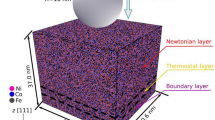Abstract
The effect of crystal orientation on nanoindentation behavior at both quasi-static and high strain rates was investigated using single-crystalline magnesium oriented in basal and prismatic configurations. Both the basal and prismatic planes had similar activation volumes, 55 and 73b 3 for deformation at room temperature, as well as a small temperature dependence up to 423 K (150 °C). Microstructural observations beneath the indentations revealed that {\( 10\bar{1}2 \)} type deformation twins were formed in both orientations irrespective of testing temperature. With twins forming beneath the indenter and multiple orientations of loading, it is believed that cross-slip and/or multiple slip are likely rate-controlling for global deformation, which also aligns with observations on nanoindentation of polycrystalline coarse-grained magnesium. The locations of the twins were consistent with expectations based on indentation mechanics as assessed by finite element simulations. The finite element simulations also predicted that an indenter tip with a shaper tip radius would tend to promote {\( 10\bar{1}2 \)} twins.








Similar content being viewed by others
References
[1] B. C. Wonsiewicz and W. A. Backofen: Trans. Metall. Sco. AIME. 1967, vol. 239, pp.1422-1431.
[2] H. Yohinaga and R. Horiuchi: Mater. Trans. JIM. 1963, vol. 4, pp.134-141.
[3] R. E. Reed-Hill and W. D. Robertson: Acta Metall. 1957, vol. 5, pp. 728-737.
[4] M. R. Barnett, Z. Keshavarz, A. G. Beer and D. Atweel: Acta Mater. 2004, vol. 52, pp.5093-5104.
[5] T. Tsuru and Y. Shibutani: Phy. Rev. B, 2007, vol. 75, 035415.
[6] G. Ziegenhain, H. M. Urbassek and A. J. Hartmaier: J. Appl. Phy. 2010, vol. 107, 061807.
[7] X. H. Liu, J. F. Gu, Y. Shen and C. F. Chen: Scripta Mater. 2008, vol. 58, pp.564-567.
[8] M. A. Tschopp, D. E. Spearot and D. L. McDowell: Mod. Sim. Mater. Sci. 2007, vol. 15, pp.693-710.
[9] J. D. Kiely and J. E. Houston: Phys. Rev. B, 1998, vol. 57, 12588.
[10] K. J. Van Vliet, J. Li, T. Zhu, S. Yip and S. Suresh: Phys. Rev. B, 2003, vol. 67, 104105.
[11] S. G. Corcoran, R. J. Colton, E. T. Lilleodden and W. W. Gerberich: Phys. Rev. B, 1997, vol. 55, 16057.
[12] J. K. Mason, A. C. Lund and C. A. Schuh: Phy. Rev. B, 2006, vol. 73, 054102.
[13] A. Gouldstone, H. J. Koh, K. Y. Zeng, A. E. Giannakopoulos and S. Suresh: Acta Mater. 2000, vol. 48, pp.2277-2295.
[14] J. Li, Y. Ni, H. Wang and J. Mei: Nanoscale. Res. Letts. 2010, vol. 5, pp.420-432.
[15] J. H. Shin, S. H. Kim, T. K. Ha, K. H. Oh, I. S. Choi and H. N. Han: Scripta Mater. 2013, vol. 68, pp.483-486.
[16] D. Catoor, Y. F. Gao, J. Geng, M. J. N. V. Prasad, E. G. Herbert, K. S. Kumar, G. M. Pharr and E. P. Gorge: Acta Mater. 2013, vol. 61, pp.2953-2965.
[17] H. Somekawa and C. A. Schuh: Scripta Mater. 2013, vol. 68, pp.416-419.
[18] H. Somekawa and C. A. Schuh: J. Mater. Res. 2012, vol. 27, pp.1205-1213.
[19] C. M. Byer, B. Li, B. Cao and K. T. Ramesh: Scripta Mater. 2010, vol. 62, pp.536-539.
[20] E. Lilleodden: Scripta Mater. 2010, vol. 62, pp.532-535.
[21] J. Ye, R. K. Mishra, A. K. Sachdev and A. M. Minor: Scripta Mater. 2011, vol. 64, pp.292-295.
[22] H. Kitahara, T. Mayama, K. Okumura, Y. Tadano, M. Tsushida and S. Ando: Acta Mater, 2014, vol. 78, pp.290-300.
[23] T. Guo, F. Siska and M. R. Barnett; Scripta Mater. 2015, vol. 110, pp.10-13.
[24] C. Zambaldi, C. Zehnder and D. Rabbe; Acta Mater. 2015, vol. 91, pp.267-288.
[25] J. Alkorta, J. M. Martinez-Esnaola and J. G. Sevillano: J. Mater. Res. 2008, vol. 23, pp.182-188.
[26] W. H. Poisl, W. C. Oliver and B. D. Fabes: J. Mater. Res. 1995, vol. 10, pp.2024-2032.
[27] J. R. Trelewicz and C. A. Schuh: Appl. Phys. Letts. 2008, vol. 93, 171916.
[28] G. Constantinides, C. A. Tweedie, N. Savva, J. F. Smith and K. J. VanVliet: Exp. Mech. 2009, vol. 49, pp.511-521.
M.M. Avedesian, and H. Baker, eds., ASM Specialty Handbook, Magnesium and Magnesium Alloys, ASM International, Materials Park, OH, 1999.
[30] H. Somekawa and T. Mukai: Scripta Mater. 2005, vol. 53, pp.541-545.
[31] W. F. Gale and T. C. Totemeier; Smithells Metals Reference Book, eight edition, Elsevier, Oxford, 2004.
ABAQUS/Explicit ver 63 (2003) User’s Manual, Theory Manual, Habbit, Karlsson & Sorensen, Inc, Providence.
[33] H. Somekawa, T. Inoue and T. Mukai: Mater. Sci. Eng. 2010, vol. A527, pp.1761-1768.
[34] A. Akhtar and E. Teghtsoonian: Acta Metall. 1969, vol. 17, pp.1339-1350.
[35] A. Akhtar and E. Teghtsoonian: Acta Metall. 1969, Vol. 17, pp.1351-1356.
[36] H. J. Frost and M. F. Ashby, Deformation-mechanism Map, Pergaman Press, Oxford, 1982.
[37] W. F. Sheely and R. R. Nash: Trans. Metall. Soc. AIME. 1960, vol. 218, pp.416-423.
P. Wardflynn, J. Mote and J. E. Dorn: Trans. Metall. Soc. AIME. 1961, vol. 221, pp.1148-1154.
[39] S. Gollapudi, M. A. Azeem, T. Tweari and U. Ramamurty: Scripta Mater. 2011, vol. 64, pp.189-192.
[40] S. J. Lloyd, J. M. Molina-Aldareguia and W. J. Clegg: Philo. Mag. 2002, vol. 82A, pp.1963-1970.
Acknowledgments
The authors are grateful to Dr. A. F. Schwartzman (Massachusetts Institute of Technology) for his help with the dynamic indentation method and Dr. T. Inoue (National Institute for Materials Science) for his contractive discussion about FE simulation. This work was supported at MIT by the US Army Research Office through the Institute for Solider Nanotechnologies and by the JSPS Grant-in-Aid (C) No. 25420765.
Author information
Authors and Affiliations
Corresponding authors
Additional information
Manuscript submitted June 13, 2015.
Rights and permissions
About this article
Cite this article
Somekawa, H., Schuh, C.A. Effect of Crystal Orientation on Nanoindentation Behavior in Magnesium. Metall Mater Trans A 47, 3227–3234 (2016). https://doi.org/10.1007/s11661-016-3479-6
Published:
Issue Date:
DOI: https://doi.org/10.1007/s11661-016-3479-6




